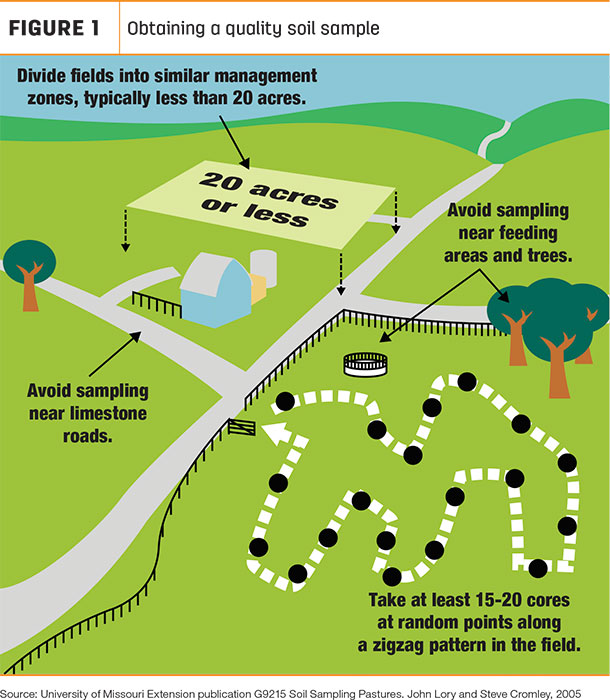Soil fertility testing is a valuable tool to optimize forage production. Applying too much fertilizer is not an economically or environmentally sound practice, and inadequate fertility or improper soil pH can limit forage production. Soil testing is a process which measures the nutrients available in the soil to support plant growth. The soil test results are interpreted and recommendations for limestone and fertilizer applications are made based on the crop being grown and the desired level of plant production or yield.
What will it tell me?
A basic soil test will analyze the sample for phosphorus, potassium, calcium, magnesium, organic matter, pH, cation exchange capacity and neutralizable acidity. Additional tests can be run for secondary and micronutrients. Nitrogen levels are not included in a basic soil test. There are numerous factors which impact the nitrogen level in the soil, and it changes quickly. Nitrogen fertilizer recommendations are based on the crop grown and the desired yield in a growing season.
The key to getting an accurate soil test report is collecting a representative soil sample. The results you get are only as good as the sample you submit. A few ounces of soil are tested in the laboratory to determine the fertility of millions of pounds of soil in the field. Soil samples should be taken every three to five years to identify trends in the soil nutrient levels and the pH level.
When and how to sample
Samples can be collected any time of year. In order to compare differences over time, consistently take samples the same time of year to avoid seasonal variations. Wait at least three months after the application of soil amendments like phosphorus fertilizer, limestone or manure before sampling.
Soils can be extremely variable within a pasture or hay field. Begin by identifying variations and sample accordingly. Divide large fields into smaller tracts of 20 acres or fewer. Each tract should represent an area which is similar in soil type, landscape position and historical management. Soil type and organic matter content affects a soil’s ability to retain nutrients. Ridgetops and side slopes tend to be more eroded than toe slopes and valleys. This leads to differences in soil fertility, organic matter and other soil properties.

Human activities have an effect on soil fertility. Manure hauled to a field from a barn on an old homestead may affect the soil fertility for many years. Fences may have been moved or completely taken out, but historical differences in which crops were grown, how the fields were fertilized or differences in hay harvest or grazing management will remain.
Animal activities also have an effect on soil fertility. Avoid sampling areas in pastures where animals congregate, such as hay feeding sites, water tanks and shade trees. These areas will be higher in nutrients because animal manure will be concentrated there.
Get started
Use a coring device such as a soil probe or auger to collect soil to a depth of 6 to 7 inches. Sampling less than 6 inches deep typically overestimates soil fertility, and deeper samples may underestimate fertility levels. Avoid areas which are not representative of the majority of the field, are known hot spots or areas along a gravel road. Dust from crushed limestone on the road can drift onto the field, raising pH in the 100 to 150 feet adjacent to the road.
Travel in a zigzag pattern through the area, collecting 15 to 20 soil cores for each sample. When the sample area is very uniform, 15 cores are adequate. When the area is variable, 20 or more cores should be collected. Insert the probe or auger straight into the ground, not at an angle. Discard any plant material on the top of the sample and any soil more than 7 inches deep. Uniform sampling is important to obtain accurate results. More care must be taken when using a soil auger to ensure sampling depth is uniform. Place soil cores in a clean plastic bucket and remove debris such as rocks and plant roots. Mix thoroughly and place approximately 1 pint of soil in a sample box or bag.
What about grids?
Grid sampling is gaining in popularity in pastures and hay fields. Samples are taken on smaller tracts, usually 1 to 5 acres. This sampling technique utilizes variable-rate fertilizer application equipment. Areas which are lower in fertility or pH can be targeted with higher fertilizer or lime applications. Areas with adequate fertility and pH can be left untreated, minimizing overapplication and reducing the potential for nutrient runoff and leaching into water sources. Collect five to 10 soil cores when grid sampling. Less variability is expected in the smaller tract. Grid sampling can provide valuable information when soil testing a field for the first time or when productivity is inconsistent across a field.
Soil testing is an effective management tool for making hay and pasture fertilizer decisions. Fertilizer recommendations and adjustment to soil pH levels that are based on soil analysis provide a basis for economically practical and environmentally friendly.







